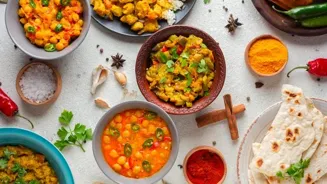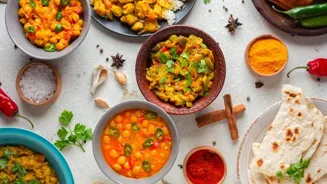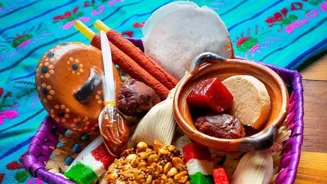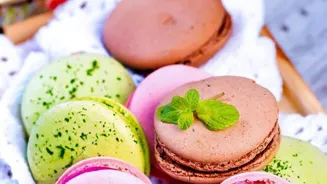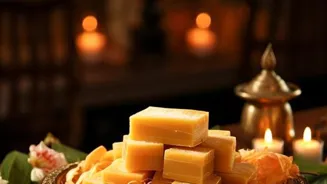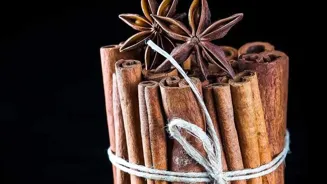Unlock the secrets to perfect Indian sweets' texture! Dive into tips & tricks for Diwali mithai mastery. Read more
Diwali is time to make mithai, folks! Nothing beats the joy of biting into a perfectly
made laddu or a melt-in-your-mouth barfi, especially when you've made it yourself. But achieving that desired texture in Indian sweets can be a bit tricky.
Sometimes the gulab jamuns turn out hard, or the jalebis end up soggy. Fear not! This article is your ultimate guide to mastering the art of Indian sweets and getting that texture just right, every single time.
It's all about understanding the ingredients, techniques, and knowing those little secrets that our grandmothers used to swear by. So, grab your apron, and let's get started!
Quality ingredients crucial for perfect mithai, from milk to ghee
The foundation of any good mithai lies in the quality of its ingredients. For instance, when making sweets like gulab jamun or kalakand, the freshness of the milk and chenna (paneer) matters a lot.
Always use full-fat milk for the best results, as the fat content contributes to the richness and texture of the sweet. Ensure the chenna is soft and crumbly, not dry or rubbery. If you're using khoya (milk solids), buy it from a trusted source or make it at home for guaranteed freshness.
Similarly, the type of flour you use can significantly impact the outcome. Besan (gram flour) should be fresh and finely ground for sweets like besan laddu or Mysore pak. Using old or coarse besan can result in a grainy texture.
And finally, don’t underestimate the power of good quality ghee (clarified butter). It adds a distinct flavor and helps in achieving the perfect texture. Remember, compromising on ingredients is never a good idea if you want that perfect mithai!
A common mistake is to think “chalta hai” with ingredient quality, but honestly, it majorly affects the final product.
Understanding the importance of sugar in making Indian sweets
Understanding the role of sugar is also very important. Sugar is not just for sweetness; it also affects the texture. In sweets like jalebi or imarti, the sugar syrup needs to be of the right consistency. If the syrup is too thin, the sweets will become soggy. If it's too thick, it will crystallize.
The "one string consistency" or "two string consistency" is often mentioned in recipes, and it's crucial to follow it accurately. This refers to the length of the thread formed when you take a small amount of syrup between your fingers and pull them apart.
Similarly, in sweets like peda or barfi, the ratio of sugar to other ingredients is important. Too much sugar can make the sweet hard, while too little can make it crumbly. The right balance is key. Also, the type of sugar matters.
Some people prefer using powdered sugar for a smoother texture, while others use granulated sugar. This is one place where experience helps, so don’t be afraid to experiment a little. Keep a small notebook handy to jot down what you tried and how it worked out.
That way, you’ll slowly build up your mithai-making know-how.
Proper techniques are crucial in Indian sweets preparation
Now, let's talk about techniques. Proper mixing and kneading are important for achieving the right texture. For instance, when making gulab jamun dough, avoid over-kneading, as it can make the gulab jamuns hard. Gently mix the ingredients until just combined.
Similarly, when making barfi, stirring it continuously over low heat is crucial to prevent it from burning and to achieve a smooth texture. Frying techniques also play a significant role. For example, gulab jamuns should be fried on low heat until they are golden brown.
Frying them on high heat will cook them quickly on the outside but leave them raw on the inside. For jalebis, the oil or ghee should be at the right temperature to ensure they are crispy. Using the right utensils also matters.
A heavy-bottomed pan is ideal for making sweets like barfi or halwa, as it prevents them from burning. A good quality frying pan is essential for frying sweets like gulab jamun or jalebi. So, pay attention to the small details, and you'll be well on your way to making perfect mithai.
Don't rush the process, and remember, patience is key.
Temperature control is crucial for perfect sweet making
Temperature control is another critical aspect. Cooking sweets at the right temperature is essential for achieving the desired texture. For instance, when making halwa, cooking it on low to medium heat allows the ingredients to blend together properly, resulting in a smooth and creamy texture.
Similarly, when making sugar syrup, maintaining the right temperature is crucial to achieve the desired consistency. Too high a temperature can cause the syrup to crystallize, while too low a temperature can make it too thin.
Using a candy thermometer can be helpful in ensuring the temperature is just right. Cooling the sweets properly is also important. For example, barfi needs to be cooled completely before cutting it into pieces.
Putting it in the refrigerator to cool it down too quickly can affect the texture and make it hard. So, pay attention to the temperature throughout the entire process, from cooking to cooling, to ensure your sweets turn out perfectly.
Many recipes will say "cook on a low flame," but what does "low" REALLY mean? This is where experience comes in. Get to know your stove and how it behaves.
Enhance sweets with magic touches: cardamom, saffron, rose water, garnishes elevate flavors
Adding little touch of magic that can elevate your sweets from good to great. For sweets like peda or sandesh, a pinch of cardamom powder can add a delightful aroma and flavor. A few strands of saffron can enhance the color and taste of sweets like kesar pista barfi or rasmalai.
A dash of rose water can add a touch of elegance to sweets like gulab jamun or phirni. And don't forget garnishing! A sprinkle of chopped nuts, a drizzle of melted chocolate, or a few edible silver leaves can add a nice visual appeal and make your sweets even more tempting.
These small additions can make a big difference in the overall taste and presentation of your sweets. Think of them as the final flourish that takes your mithai to the next level! Don’t be scared to try new things!
Maybe your family has always made barfi a certain way, but what if you added a little bit of orange zest? It might be amazing!
Making Indian sweets is a labor of love, requiring patience and practice to master
Making Indian sweets is a labor of love. It requires patience, attention to detail, and a willingness to experiment. But when you finally bite into a perfectly made laddu or barfi, it's all worth it. So, don't be discouraged if your first few attempts aren't perfect.
Keep practicing, keep learning, and most importantly, keep enjoying the process. With a little bit of effort and these tips and tricks, you'll be able to master the art of making Indian sweets and impress your family and friends with your culinary skills. Happy sweet-making and Happy Diwali!
And remember, even if your mithai isn’t picture-perfect, it will still taste delicious because it’s made with love! So go ahead, embrace the imperfections, and enjoy the sweet rewards of your efforts.
AI Generated Content. Glance/InMobi shall have no liability for the content